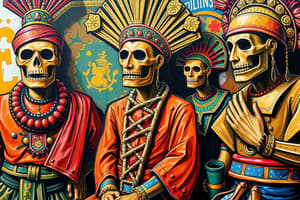Podcast
Questions and Answers
Which traditional clothing is associated with rural Ilocano culture?
Which traditional clothing is associated with rural Ilocano culture?
- Kimona
- Chambara (correct)
- Camisa de Ching
- Balintawak
What is the common male attire in Cordillera Tribal culture?
What is the common male attire in Cordillera Tribal culture?
- Malong
- Soft panuelo
- Barang and trousers of any color (correct)
- F-Hinabi ra tela
Which combination of clothing is typically worn by rural Tagalog women?
Which combination of clothing is typically worn by rural Tagalog women?
- F-Hinabi ra tela and trousers
- Malong and Kimona
- Siesop and bahag
- Balintawak and tapis (correct)
In Visauan rural culture, which accessory is commonly associated with traditional costumes?
In Visauan rural culture, which accessory is commonly associated with traditional costumes?
Match the following cultural dances with their respective origins:
Match the following cultural dances with their respective origins:
What type of headgear is typically worn in Cordillera Tribal attire?
What type of headgear is typically worn in Cordillera Tribal attire?
Match the clothing items with their associated cultural influences:
Match the clothing items with their associated cultural influences:
Match the types of dances to their characteristics:
Match the types of dances to their characteristics:
Match the descriptions to the corresponding attire:
Match the descriptions to the corresponding attire:
Match the dances with their cultural attributes:
Match the dances with their cultural attributes:
Study Notes
Cultural Clothing and Textiles in the Philippines
- Muslim Traditional Attire: Includes distinct clothing items such as the malong, recognized for its versatility and cultural significance, suitable for both men and women.
- Sigpit or Sablay: Traditional garments worn over the body, reflecting regional identities within the Philippines.
- Paradyang: A type of garment commonly worn in various Filipino cultural practices, showcasing local craftsmanship.
Regional Attire
- Rural Visayan Attire: Characterized by the use of traditional fabrics and designs, representing the distinct culture of the Visayas region.
- Cordillera Tribal Wear: Features unique elements such as M-G strings, jackets, and feathered headdresses that symbolize tribal identity and heritage.
Textiles and Accessories
- F-Hinabi Fabric (Hablon): A traditional woven textile that is often used for making accessories like beads, integral to Filipino fashion.
- Kimona and Patadyong: Commonly worn by women, often accompanied by a kerchief, highlighting traditional Filipino feminine attire.
Ilocano Attire
- Components of Ilocano Clothing: Men wear trousers in various colors while women don chambara (blouses) and siesop (La line skirts), showcasing regional variations and styles.
Spanish Influence on Filipino Fashion
- Typical Spanish Elite Fashion: This reflects colonial influence in Filipino clothing styles.
- Rural Tagalog Clothing:
- Women wear balintawak, characterized by a soft panuelo (shawl) and tapis (skirt).
- Men wear camisa de Chino (collared shirts) paired with trousers in various color palettes, illustrating fusion of Spanish and local styles.
Cultural Attire and Influences
- Faraduang, Malang, and rural Visoup represent traditional regional garments.
- Cordillera Gazal refers to specific clothing items linked to the indigenous groups in the Cordilleras.
- F. Kimona and Rita reflect traditional Filipino attire, often accompanied by kerchiefs.
- Barang signifies the color variations in traditional pants, often worn by local communities.
Dance Forms and Tribal Influence
- Tribal dances include T'bol and Manobo, showcasing regional cultural expressions.
- Maranao and Tausug represent the Muslim dance forms, emphasizing unique traditions.
- Ritual dances are highlighted in rural settings with elements like animal sounds and movements that reflect nature.
Characteristics of Traditional Dance
- Rural bapleg and other dances depict simple lifestyles through movements and themes.
- Performances like Maglalatik convey historical and agricultural aspects with rhythmic patterns.
- Influences from Malay culture can be seen in various traditional forms, highlighting regional connections.
Symbolism and Religion
- Shimmering costumes in dances symbolize royalty and beauty, showcasing the culture's heritage.
- Some costumes and performances reflect Christian influences, evident in styles resembling Spanish traditions.
- Dance forms such as joras, fandangos, and mazurkas integrate diverse cultural narratives into contemporary expressions.
Youth Engagement in Culture
- Young individuals actively participate in dance forms, maintaining cultural continuity and traditions.
- The performance of traditional dances not only preserves heritage but also serves as a platform for community bonding.
Studying That Suits You
Use AI to generate personalized quizzes and flashcards to suit your learning preferences.
Description
Test your knowledge on various traditional Filipino attires across different cultures and regions. From the rural styles of the Visayas to the elegance of the Spanish elite, explore the diverse clothing that represents the rich heritage of the Philippines.




